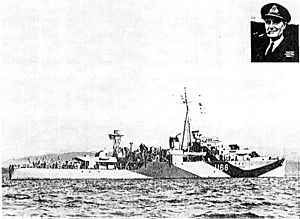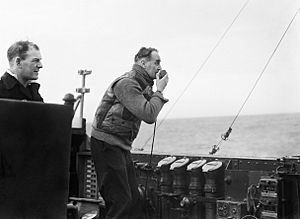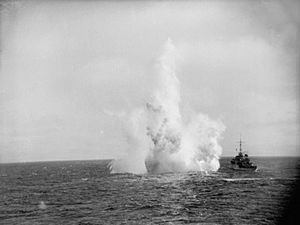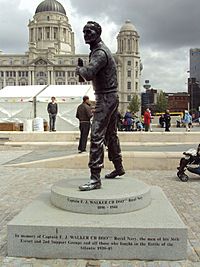Frederic John Walker facts for kids
Quick facts for kids
Frederic John Walker
|
|
|---|---|
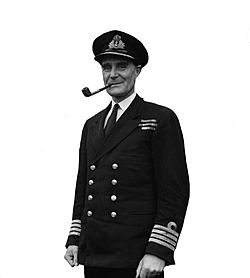
Captain Frederic Walker c.1944
|
|
| Nickname(s) | "Johnnie" |
| Born | 3 June 1896 Plymouth, England |
| Died | 9 July 1944 (aged 48) Seaforth, Merseyside, England |
| Allegiance | United Kingdom |
| Service/ |
Royal Navy |
| Years of service | 1909–1944 |
| Rank | Captain |
| Commands held | HMS Shikari (1933) HMS Falmouth (1933–1935) HMS Stork (1941–1942) 36th Escort Group (1941–1942) HMS Starling (1943–1944) 2nd Support Group (1943–1944) |
| Battles/wars | First World War Second World War |
| Awards | Companion of the Order of the Bath Distinguished Service Order & Three Bars Mentioned in Despatches (3) |
Frederic John Walker (born June 3, 1896 – died July 9, 1944) was a brave officer in the Royal Navy. He became famous for his amazing work during the Second World War. Walker was the best commander at fighting against enemy submarines, especially during the Battle of the Atlantic. People often called him "Johnnie Walker."
Contents
Frederic John Walker was born in Plymouth, England. He joined the Royal Navy when he was just 13 years old in 1909. He studied at special naval colleges and was a very good student.
After his training, he served on different ships. He was on a battleship called Ajax and later on destroyers like Mermaid. After the First World War, he joined another battleship, Valiant. He got married and had three sons and a daughter.
Learning to Hunt Submarines
Between the two World Wars, Walker became very interested in fighting submarines. He went to a special training school called HMS Osprey. There, he learned everything about how to find and destroy submarines. He became an expert in this field. In 1933, he was promoted to commander. He then led ships like Shikari and Falmouth. By 1937, he was the main expert at the anti-submarine school.
World War II Hero
When the Second World War started in 1939, Walker's career seemed to be ending. He hadn't been promoted to captain and was set to retire early. But the war changed everything! In 1940, he helped plan the Operation Dynamo. This was a huge rescue mission where over 330,000 British and French soldiers were saved from Dunkirk, France. He was recognized for his important work during this rescue.
Leading the Fight Against U-boats
In October 1941, Walker finally got his own command. He led the 36th Escort Group from his ship, Stork. This group was based in Liverpool and protected convoys (groups of ships) traveling to and from Gibraltar.
Walker's group first showed their skills in December 1941. They were protecting Convoy HG 76, a group of 32 ships. During this journey, they sank five German submarines, called U-boats. Four of these were sunk by Walker's group. His own ship, Stork, even rammed one U-boat after hitting it with depth-charges. This battle is often seen as the first big victory for the Allies in the Battle of the Atlantic. For his bravery and skill, Walker received the Distinguished Service Order (DSO) award. He earned another award (a "Bar" to his DSO) in July 1942 for sinking more U-boats.
After a short break, Walker returned to sea in 1943. He became the commander of the 2nd Support Group. He led this group from his new ship, Starling. This group was special because its main job was to actively hunt and destroy U-boats, not just protect convoys. Walker had suggested this new idea himself. He was known for playing the song "A Hunting We Will Go" over his ship's speakers when they returned to base after a successful hunt!
More Victories at Sea
In June 1943, Walker's ship Starling sank two U-boats. His group also sank another U-boat on the same day. Later, in July, his group found three U-boats in the Bay of Biscay. Two of these were "Milk Cows," which were special U-boats that resupplied others. Walker ordered a "General Chase" and attacked them. His group sank two of these important U-boats.
When Walker returned to Liverpool, he learned sad news. His son, Timothy, had been killed when his submarine was lost. Despite this, Walker continued his important work. He received another award, the Companion of the Order of the Bath, for his leadership against U-boats.
In early 1944, Walker's group had an incredible patrol. They sank six U-boats in just one trip! This included three U-boats sunk in a single action on February 9. One ship in his group, HMS Woodpecker, was hit by a torpedo but all its crew were saved. When they returned to Liverpool, the city celebrated their heroes. Walker was promoted to captain and received another award (a second Bar to his DSO).
Walker's last big mission was protecting the ships during the Normandy landings. This was the huge Allied invasion of France. For two weeks, he successfully kept U-boats away from the invasion fleet. No U-boats got past his ships, and many were sunk or damaged. Walker worked tirelessly during this time, which sadly took a toll on his health. He received a third Bar to his DSO for his outstanding leadership.
Walker's Clever Tactics
Walker used smart tactics to fight U-boats. One was called the "creeping attack." In this method, two ships would work together. One ship would keep track of the U-boat, while the other would drop depth charges. He also used a "barrage attack," where several ships would drop depth charges in a line to cover a large area. Walker was also good at keeping U-boats deep underwater until they ran out of air or battery power, forcing them to surface where they could be attacked.
He was the most successful anti-submarine commander of the Second World War. He is credited with destroying 17 U-boats!
His Final Days
Captain Walker became very ill on July 7, 1944, and passed away two days later at the age of 48. His death was caused by overwork and exhaustion from his demanding duties.
His funeral was held with full naval honors in Liverpool. Many people attended, and his body was carried through the streets to the docks. He was then buried at sea from the destroyer Hesperus.
Remembering a Hero
In 1998, a statue of Captain Walker was put up at the Pier Head in Liverpool. It was unveiled by Prince Philip. This statue helps people remember his bravery and important contributions during the war. The ship's bell from his famous ship, HMS Starling, was also given to Bootle Town Hall to honor him.
Awards and Recognition
Captain Walker received many awards for his courage and skill:
- Mentioned in Despatches (August 1940): For his staff work during the Dunkirk evacuation.
- Distinguished Service Order (DSO) (January 1942): For protecting a convoy and sinking three enemy submarines.
- Bar to the DSO (July 1942): For his leadership against enemy submarines.
- Companion of the Order of the Bath (September 1943): For his daring command of HMS Starling in successful actions.
- Second Bar to the DSO (February 1944): For destroying two U-boats in the North Atlantic.
- Third Bar to the DSO (June 1944): For outstanding leadership and destroying six U-boats while protecting convoys.
- Mentioned in Despatches (June 1944): For his excellent leadership during convoy escort duty.
- Mentioned in Despatches (August 1944, posthumous): For his actions in hunting and destroying a U-boat in May 1944.


